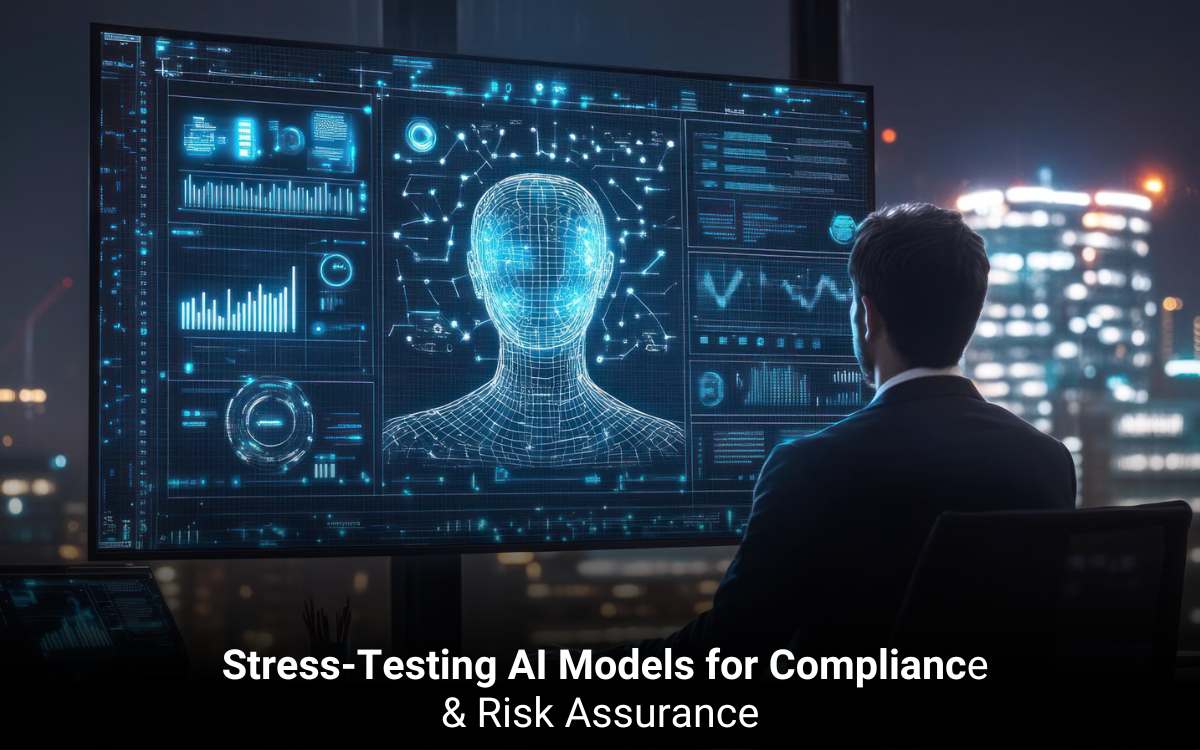Stress-Testing AI Models for Compliance & Risk Assurance

A global bank deploys an AI model to automate loan approvals. First, approvals are fast and operational costs are down. But soon, regulators flag bias in the model’s decisions, revealing that certain groups are denied loans. The model brings fines, reputational damage, and regulatory scrutiny. But if they had stress-tested AI models for compliance and risk, the situation could have been avoided.
Organizations are no longer judged only for their innovation but also by their ability to uphold transparency and fairness in decision-making. Stress-testing AI models is the equivalent of running a “crash test,” helping leaders understand how resilient they are to unexpected scenarios, and whether they comply with evolving regulations.
This article discusses the importance of stress testing AI models for compliance and risk.
Why Stress-Testing AI Models Matters
Here’s why stress testing AI models is essential for your organization.
1. Safeguarding Against Regulatory Risks
Regulators have strict rules on how organizations must use AI responsibly. Stress-testing an AI model ensures it can withstand compliance checks by validating accountability before deployment.
Example: A financial services firm deploying AI for credit risk assessment must stress-test its model to confirm that no customer segment is unfairly disadvantaged.
2. Building Trust with Enterprise Clients
Enterprise clients expect vendors to demonstrate responsible innovation. Stress-testing shows due diligence in AI compliance, signaling that the business is taking it seriously.
Example: A SaaS provider offering AI-driven HR solutions can win trust by demonstrating through stress tests that its model avoids biases in candidate selection.
3. Mitigating Operational Risks
Stress-testing helps identify weaknesses in how a model responds to data drift, different inputs, or unstructured data.
Example: A logistics firm using AI to optimize supply chains can stress-test its model against sudden disruptions to ensure continuity of operations.
4. Protecting Brand Reputation
A single compliance breach or error can erode brand equity. Stress-testing protects before they escalate.
Example: A healthcare data company stress-tests its AI model to confirm compliance with HIPAA and GDPR, avoiding breaches.
5. Futureproofing Against Evolving Standards
Regulatory frameworks for AI are still maturing. Stress-testing helps businesses stay ahead of evolving laws and industry benchmarks.
Example: An insurance provider using AI for claims automation can simulate future regulatory standards by testing Explainability, ensuring compliance even as rules tighten.
Key Areas in Stress-Testing AI Models
Here are the different testing scenarios that you need to stress test in your AI model.
1. Regulatory and Compliance
Stress-testing simulates regulatory reviews, audits, and fairness checks to confirm the AI model can withstand scrutiny.
A financial institution stress-tests its credit scoring model against regulatory frameworks like the EU AI Act to validate its performance.
2. Bias and Fairness Testing
Bias can undermine trust and create challenges. Stress-testing evaluates whether models treat all groups equally.
Example: A HRTech provider offering AI-based recruitment platforms stress-tests its algorithms to confirm equal opportunities for diverse candidates.
3. Resilience to Data Drift
Real-world data changes over time, which affects AI performance. Stress-testing anticipates such data drifts by simulating shifts in input quality, sources, or volume.
Example: A supply chain solutions provider stress-tests its demand forecasting model with different data types to ensure operational continuity.
4. Cybersecurity Testing
Malicious inputs can manipulate AI systems. Stress-testing involves simulating attacks to assess system resilience.
Example: A cybersecurity company stress-tests its anomaly detection AI model against traffic injections to ensure it continues to detect breaches.
5. Explainability and Transparency Checks
C-suite leaders need to explain AI decisions to regulators, clients, and stakeholders. Stress-testing verifies whether models can provide reasoning for their outputs.
Example: An insurance provider stress-tests its claims automation model to ensure every decision can be explained to both regulators and clients.
Best Practices for Stress-Testing AI Models
Here are the different approaches to stress testing your AI models.
1. Test for Bias and Fairness Early
Bias, if left unchecked, can create both legal and reputational risks. Stress-testing models across demographics ensures ethical deployment.
Example: A recruitment SaaS provider stress-tests its AI hiring model to guarantee fair candidate recommendations.
2. Simulate Adverse Scenarios
Stress-testing must go beyond average in use cases to evaluate how an AI model performs in worst-case scenarios.
Example: A supply chain analytics company tests its demand forecasting AI against events such as raw material shortages to ensure continuity.
3. Prioritize Explainability
Stress-testing should validate whether regulators and clients can clearly interpret outputs.
Example: An insurance firm stress-tests its claims AI to ensure decision logs are auditable and easily explained in customer disputes.
4. Embed Stress-Testing into Continuous Monitoring
Stress-testing must be integrated into ongoing risk assurance frameworks to keep models compliant.
Example: A healthcare analytics provider establishes quarterly stress-testing cycles for its diagnostic AI models with HIPAA and GDPR requirements.
Conclusion
Risk assurance addresses the strategic resilience of AI. AI Models exposed to stress-testing are better equipped to handle market shifts, data drifts, and emerging threats. It makes it a reliable tool for scaling operations and entering new markets. The organizations that will lead are those that recognize stress-testing as a continuous discipline. It will transform AI into an asset that drives sustainable growth and long-term trust. If your organization is scaling AI, now is the time to embed stress-testing into your governance framework.
Partner with compliance experts, invest in robust testing frameworks, and make stress-testing a pillar of your AI strategy. The future will belong to those who innovate responsibly and build resilience into every model they deploy.



